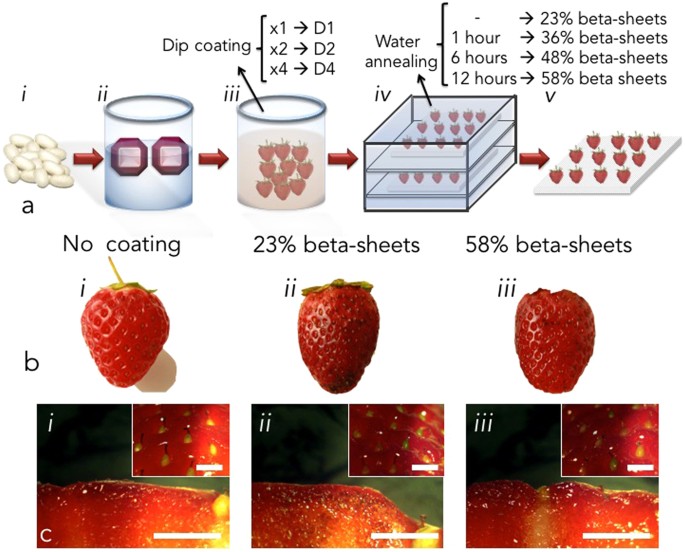(MIT startup wraps food in silk for better shelf life)
2020/6/5 アメリカ合衆国・マサチューセッツ工科大学(MIT)

・ MIT のスタートアップ、Cambridge Crops が開発した、生鮮食品の保存可能期間を延長する、シルクによる可食性コーティング技術が間もなく商業化される。
・ シルクのバイオ医療アプリケーション開発に従事してきた MIT の研究者が、シルクに浸したイチゴの保存状態が良好であったことを偶然に発見。食品ロスの課題の解決を目指しシルクの能力の研究に着手した。
・ 世界の年間食品供給量の 1/3 が廃棄される一方で、世界人口の 10%超が飢餓に直面している。食品ロスは、先進国・開発途上国ともに社会、経済、健康面に膨大な影響を及ぼす問題。
・ 生鮮食品保存技術は、遺伝子工学、機械工学、AI やコンピュータサイエンスによるものが主流となっているが、ナノ・バイオ技術の利用により、食品元来の性質を変えることなく、食品産業が抱える様々な問題の解決に貢献できると考える。
・ シルクの強度は、数千年間におよぶ生物の進化で磨き上げられた自然の単純さに由来する。Cambridge Crops のシルクコーティング剤は、効率的な特許プロセスにより水と塩のみでシルクのタンパク質を分離・再形成するため、高コストの機器や改修の必要なく既存の食品加工ラインに容易に導入できる。
・ 食品の表面を同シルクコーティング剤で処理すると、無味無臭で目に見えないバリアを形成し、食品の自然な劣化メカニズムを減速させる。
・ 品目によって保存期間を最高で 200%延長。切り分けた食品や肉、魚、加工食品でも同様の効果を発揮する。食品ロスに加え、低温物流による温暖化ガス排出量の低減も期待できる。
・ Cambridge Crops は、2017 年に Rabobank と Abdul Latif Jameel Water and Food Systems Lab (JWAFS)が主催し、MIT Food and Agriculture club が支援する Rabobank-MIT Food and Agriburisness
Innovation Prize で優勝し、同シルクコーティング技術の検証とバリュー・プロポジションを実施。
・ 以来「tough tech」を扱うスタートアップのインキュベーターである The Engine の主導による 2 度の資金調達や、AgFunder によるアワードや Massachusetts Clean Energy Center グラントを受領。また、ビル・ゲイツが「Gates Notes」で同社の初期の成功について言及している。
URL: http://news.mit.edu/2020/mit-based-startup-cambridge-crops-wraps-food-in-silk-0605
<NDO海外技術情報より>
(関連情報)
Scientific Reports 掲載論文(フルテキスト)
Silk Fibroin as Edible Coating for Perishable Food Preservation
URL: https://www.nature.com/articles/srep25263
Abstract
The regeneration of structural biopolymers into micelles or nanoparticles suspended in water has enabled the design of new materials with unique and compelling properties that can serve at the interface between the biotic and the abiotic worlds. In this study, we leveraged silk fibroin quintessential properties (i.e. polymorphism, conformability and hydrophobicity) to design a water-based protein suspension that self-assembles on the surface of food upon dip coating. The water-based post-processing control of the protein polymorphism enables the modulation of the diffusion of gases through the silk fibroin thin membranes (e.g. O2 and CO2 diffusion, water vapour permeability), which is a key parameter to manage food freshness. In particular, an increased beta-sheet content corresponds to a reduction in oxygen diffusion through silk fibroin thin films. By using the dip coating of strawberries and bananas as proof of principle, we have shown that the formation of micrometre-thin silk fibroin membranes around the fruits helps the management of postharvest physiology of the fruits. Thus, silk fibroin coatings enhance fruits’ shelf life at room conditions by reducing cell respiration rate and water evaporation. The water-based processing and edible nature of silk fibroin makes this approach a promising alternative for food preservation with a naturally derived material.



